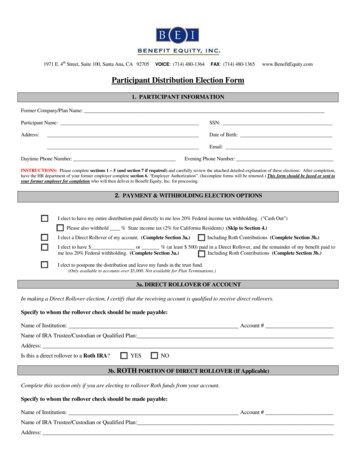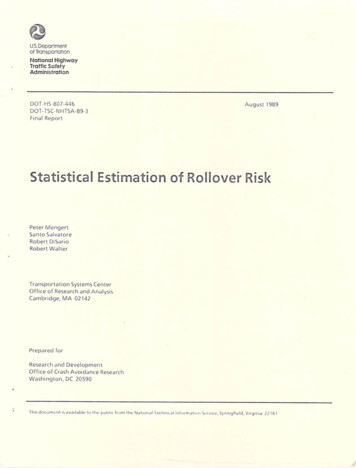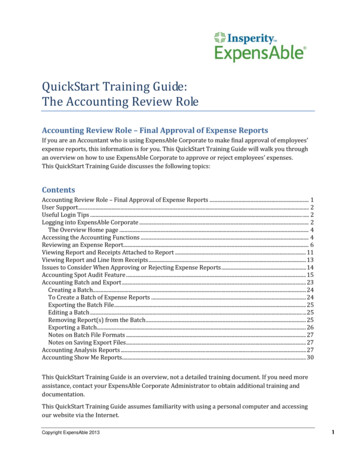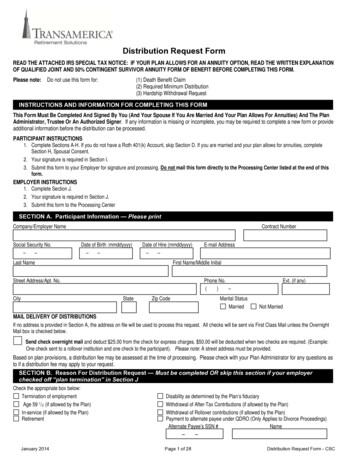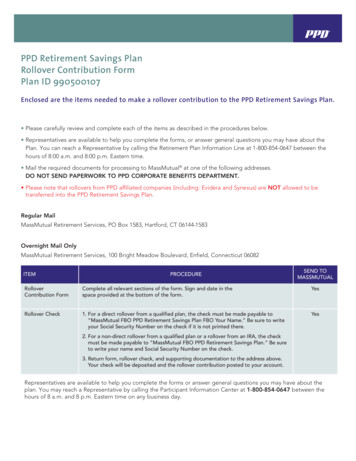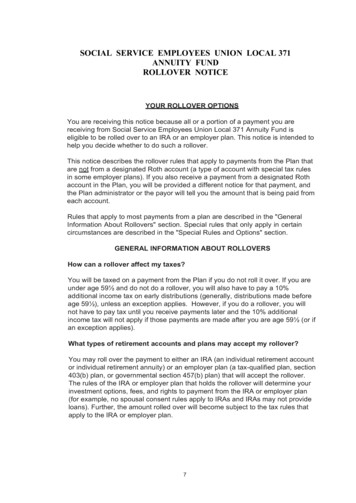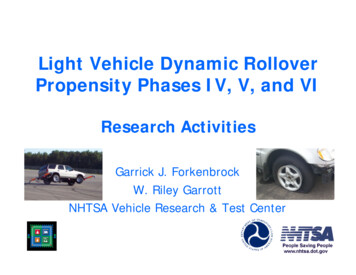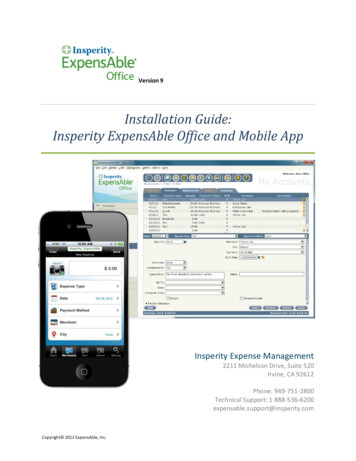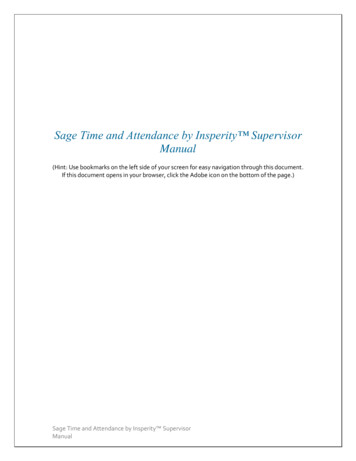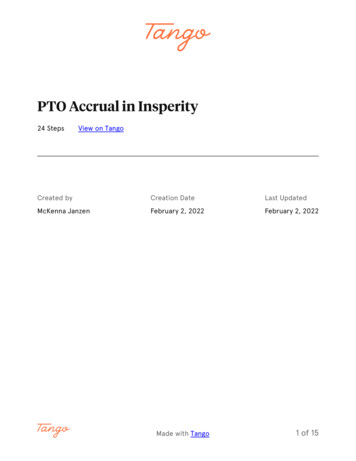
Transcription
IMPORTANT INFORMATION REGARDINGDISTRIBUTIONS FROM YOUR 401(K) ACCOUNTAll distributions are issued in the form of a check, mailed to the address on file. Please make sure you have properpayee information available when you request a distribution and confirm that we have your current address on file.Please be advised that you will have to pay an additional fee if you need a check re-issued.To Request a Distribution:OnlineYou may access your account online in the Retirement Service CenterSM via Insperity PremierTM,located at portal.insperity.com (click on 401(k) and then Manage My 401(k)). If you do not haveaccess to Insperity Premier, log in directly at https://retirement.insperity.com. Once in youraccount, select the Distributions tab and follow the steps.By telephoneIf you have any questions, you may call the Contact Center specialists at 866-715-3552,option 3. Insperity 401(k) Contact Center specialists are available Monday through Fridaybetween 7 a.m. and 7 p.m. CT.Processing feeEach distribution (including any lump sum and partial distribution) is subject to a 50 processingfee, which will be deducted from your account balance. There is an additional fee if you need acheck re-issued or overnighted. All fees are subject to change.Options for Your Distribution:If your distribution isDirect RolloverA “direct rollover” is a direct payment of your vested account balance to an individualretirement account (IRA), Roth IRA, or to another employer plan that will accept it. Thecheck will be issued in the name of the receiving IRA, Roth IRA, or employer plan andmailed to you for forwarding.Lump Sum or PartialPaymentYou may elect to receive all or any portion of your account balance. The taxable portion ofyour payment will be subject to mandatory 20% federal income tax withholding, and may besubject to a 10% early withdrawal penalty.Combination of LumpSum Payment andDirect RolloverYou may request that a portion of your vested account balance be paid as a direct rollover,with the remaining portion payable to you. The taxable portion of your payment not directlyrolled over will be subject to mandatory 20% federal income tax withholdingand may besubject to a 10% early withdrawal penalty.If You Have an Outstanding Loan Balance: Loans may be rolled to another employer’s plan provided that the receiving plan will accept the loan as part of youreligible rollover contribution. Please consult the Plan’s Loan Rollover Form. Loans may not be rolled over to an IRA. If your Plan treats an outstanding loan balance as a loan offset against your account when you take a distribution, theoffset amount may be subject to tax withholding and reporting depending on the circumstances, including whether itwas previously deemed distributed (such as for default) and the extent to which it includes amounts from adesignated Roth account. You may be able to indirectly roll over the offset amount as described in the Special TaxNotice(s), which may defer taxation on the offset amount. Consult a tax adviser for further details.To help you make a decision regarding a distribution, the Special Tax Notice(s) on the following pages provides furtherinformation outlining the options and consequences. You should consult with your tax adviser to determine the financialimpact of your distribution. Note: There are separate notices for payments from a designated Roth account and forpayments not from a designated Roth account.40022a 10-12-2021
SPECIAL TAX NOTICE REGARDING PLAN PAYMENTSFROM A DESIGNATED ROTH ACCOUNTYou are receiving this notice because all or a portion of a payment you are receiving from your 401(k) Plan (the “Plan”) is eligible tobe rolled over to a Roth IRA or designated Roth account in an employer plan. This notice is intended to help you decide whether todo a rollover. This notice describes the rollover rules that apply to payments from the Plan that are from a designated Roth account.If you also receive a payment from the Plan that is not from a designated Roth account, you will be provided a different notice forthat payment, and the Plan administrator will tell you the amount that is being paid from each account. Rules that apply to mostpayments from a designated Roth account are described in the “General Information About Rollovers” section. Special rules that onlyapply in certain circumstances are described in the “Special Rules and Options” section.GENERAL INFORMATION ABOUT ROLLOVERSHow can a rollover affect my taxes?After-tax contributions included in a payment from a designatedRoth account are not taxed, but earnings might be taxed. The taxtreatment of earnings included in the payment depends onwhether the payment is a qualified distribution. If a payment isonly part of your designated Roth account, the payment willinclude an allocable portion of the earnings in your designatedRoth account.If the payment from the Plan is not a qualified distribution andyou do not do a rollover to a Roth IRA or a designated Rothaccount in an employer plan, you will be taxed on the portion ofthe payment that is earnings. If you are under age 591/2, a 10%additional income tax on early distributions (generally,distributions made before age 591/2) will also apply to theearnings (unless an exception applies). However, if you do arollover, you will not have to pay taxes currently on the earningsand you will not have to pay taxes later on payments that arequalified distributions.If the payment from the Plan is a qualified distribution, you willnot be taxed on any part of the payment even if you do not do arollover. If you do a rollover, you will not be taxed on the amountyou roll over and any earnings on the amount you roll over willnot be taxed if paid later in a qualified distribution.A qualified distribution from a designated Roth account in thePlan is a payment made after you are age 591/2 (or after yourdeath or disability) and after you have had a designated Rothaccount in the Plan for at least 5 years. In applying the 5-yearrule, you count from January 1 of the year your first contributionwas made to the designated Roth account. However, if you did adirect rollover to a designated Roth account in the Plan from adesignated Roth account in another employer plan, yourparticipation will count from January 1 of the year your firstcontribution was made to the designated Roth account in the Planor, if earlier, to the designated Roth account in the otheremployer plan.What types of retirement accounts and plans may acceptmy rollover?You may roll over the payment to either a Roth IRA (a Rothindividual retirement account or Roth individual retirementannuity) or a designated Roth account in an employer plan (a taxqualified plan, section 403(b) plan, or governmental section 457plan) that will accept the rollover. The rules of the Roth IRA oremployer plan that holds the rollover will determine yourinvestment options, fees, and rights to payment from the RothIRA or employer plan (for example, Roth IRAs are not subjectto spousal consent rules, and Roth IRAs may not provide loans).Further, the amount rolled over will become subject to the taxrules that apply to the Roth IRA or the designated Roth accountin the employer plan. In general, these tax rules are similar tothose described elsewhere in this notice, but differences include: If you do a rollover to a Roth IRA, all of your Roth IRAswill be considered for purposes of determining whether youhave satisfied the 5-year rule (counting from January 1 ofthe year for which your first contribution was made to anyof your Roth IRAs). If you do a rollover to a Roth IRA, you will not be requiredto take a distribution from the Roth IRA during your lifetimeand you must keep track of the aggregate amount of the aftertax contributions in all of your Roth IRAs (in order todetermine your taxable income for later Roth IRA paymentsthat are not qualified distributions). Eligible rollover distributions from a Roth IRA can only berolled over to another Roth IRA.How do I do a rollover?There are two ways to do a rollover. You can either do a directrollover or a 60-day rollover.If you do a direct rollover, the Plan will make the paymentdirectly to your Roth IRA or designated Roth account in anemployer plan. You should contact the Roth IRA sponsor or theadministrator of the employer plan for information on how to doa direct rollover.If you do not do a direct rollover, you may still do a rollover bymaking a deposit (generally within 60 days) into a Roth IRA,whether the payment is a qualified or nonqualified distribution.In addition, you can do a rollover by making a deposit within 60days into a designated Roth account in an employer plan if thepayment is a nonqualified distribution and the rollover does notexceed the amount of the earnings in the payment. You cannotdo a 60-day rollover to an employer plan of any part of aqualified distribution. If you receive a distribution that is anonqualified distribution and you do not roll over an amount atleast equal to the earnings allocable to the distribution, you willbe taxed on the amount of those earnings not rolled over,including the 10% additional income tax on early distributions ifyou are under age 591/2 (unless an exception applies).If you do a direct rollover of only a portion of the amount paidfrom the Plan and a portion is paid to you at the same time, theportion directly rolled over consists first of earnings.Page 1 of 840022 10-12-21
SPECIAL TAX NOTICE REGARDING PLAN PAYMENTSFROM A DESIGNATED ROTH ACCOUNT Payments made under a qualified domestic relations order(QDRO); Payments of up to 5,000 made to you from a definedcontribution plan if the payment is a qualified birth oradoption distribution; Payments up to the amount of your deductible medicalexpenses (without regard to whether you itemizedeductions for the taxable year); Certain payments spread over a period of at least 10 yearsor over your life or life expectancy (or the joint lives orjoint life expectancies of you and your beneficiary);Certain payments made while you are on active duty if youwere a member of a reserve component called to duty afterSeptember 11, 2001 for more than 179 days; Required minimum distributions after age 701/2 (if youwere born before July 1, 1949), after age 72 (if you wereborn after June 30, 1949), or after death;Payments of certain automatic enrollment contributionsthat you request to withdraw within 90 days of your firstcontribution; and Payments excepted from the additional income tax byfederal legislation relating to certain emergencies anddisasters.If you do not do a direct rollover and the payment is not aqualified distribution, the Plan is required to withhold 20% of theearnings for federal income taxes (up to the amount of cash andproperty received). This means that, in order to roll over theentire payment in a 60-day rollover to a Roth IRA, you must useother funds to make up for the 20% withheld.How much may I roll over?If you wish to do a rollover, you may roll over all or part of theamount eligible for rollover. Any payment from the Plan iseligible for rollover, except: Hardship distributions; Corrective distributions of contributions that exceed taxlaw limitations;If I do a rollover to a Roth IRA, will the 10% additionalincome tax apply to early distributions from the IRA? Loans treated as deemed distributions (for example, loansin default due to missed payments before your employmentends); and Payments of certain automatic enrollment contributionsthat you request to withdraw within 90 days of your firstcontribution.If you receive a payment from a Roth IRA when you are underage 591/2, you will have to pay the 10% additional income tax onearly distributions on the earnings paid from the Roth IRA,unless an exception applies or the payment is a qualifieddistribution. In general, the exceptions to the 10% additionalincome tax for early distributions from a Roth IRA listed aboveare the same as the exceptions for early distributions from a plan.However, there are a few differences for payments from a RothIRA, including:The Plan administrator can tell you what portion of a payment iseligible for rollover.If I don’t do a rollover, will I have to pay the 10%additional income tax on early distributions?If a payment is not a qualified distribution and you are under age591/2, you will have to pay the 10% additional income tax on earlydistributions with respect to the earnings allocated to the paymentthat you do not roll over (including amounts withheld for incometax), unless one of the exceptions listed below applies. This tax isin addition to the regular income tax on the earnings not rolled over.The 10% additional income tax does not apply to the followingpayments from the Plan, if applicable: Payments made after you separate from service if you willbe at least age 55 in the year of the separation; Payments that start after you separate from service if paidat least annually in equal or close to equal amounts overyour life or life expectancy (or the joint lives or joint lifeexpectancies of you and your beneficiary); Payments made due to disability; Payments after your death; Corrective distributions of contributions that exceed taxlaw limitations; Payments made directly to the government to satisfy afederal tax levy; The exception for payments made after you separate fromservice if you will be at least age 55 in the year of theseparation does not apply; The exception for qualified domestic relations orders(QDROs) does not apply (although a special rule appliesunder which, as part of a divorce or separation agreement,a tax-free transfer may be made directly to a Roth IRA of aspouse or former spouse); and The exception for payments made at least annually in equalor close to equal amounts over a specified period applieswithout regard to whether you have had a separation fromservice.There are additional exceptions apply for payments from an IRA,including: Payments for qualified higher education expenses; Payments up to 10,000 used in a qualified first-time homepurchase; and Payments for health insurance premiums after you havereceived unemployment compensation for 12 consecutiveweeks (or would have been eligible to receiveunemployment compensation but for self-employed status).Page 2 of 840022 10-12-21
SPECIAL TAX NOTICE REGARDING PLAN PAYMENTSFROM A DESIGNATED ROTH ACCOUNTWill I owe State income taxes?If you are not a Plan participantThis notice does not address any State or local income tax rules(including withholding rules).Payments after death of the participant: If you receive adistribution after the participant’s death that you do not roll over,the distribution generally will be taxed in the same mannerdescribed elsewhere in this notice. However, whether thepayment is a qualified distribution generally depends on whenthe participant first made a contribution to the designated Rothaccount in the Plan. Also, the 10% additional income tax on earlydistributions does not apply, and the special rule described underthe section “If you receive a nonqualified distribution and youwere born on or before January 1, 1936” applies only if thedeceased participant was born on or before January 1, 1936.SPECIAL RULES AND OPTIONSIf you miss the 60-day rollover deadlineGenerally, the 60-day rollover deadline cannot be extended.However, the IRS has the limited authority to waive thedeadline under certain extraordinary circumstances, such aswhen external events prevented you from completing therollover by the 60-day rollover deadline. Under certaincircumstances, you may claim eligibility for a waiver of the 60day rollover deadline by making a written self-certification.Otherwise, to apply for a waiver from the IRS, you must file aprivate letter ruling request with the IRS. Private letter rulingrequests require the payment of a nonrefundable user fee. Formore information, see IRS Publication 590-A, Contributions toIndividual Retirement Arrangements (IRAs).If you are a surviving spouse: If you receive a paymentfrom the Plan as the surviving spouse of a deceasedparticipant, you have the same rollover options that theparticipant would have had, as described elsewhere in thisnotice. In addition, if you choose to do a rollover to a RothIRA, you may treat the Roth IRA as your own or as aninherited Roth IRA.If you have an outstanding loan that is being offsetA Roth IRA you treat as your own is treated like any otherRoth IRA of yours, so that you will not have to receive anyrequired minimum distributions during your lifetime, andearnings paid to you in a nonqualified distribution beforeyou are age 591/2 will be subject to the 10% additionalincome tax on early distributions (unless an exceptionapplies).If you have an outstanding loan from the Plan, your Plan benefitmay be offset by the outstanding amount of the loan, typicallywhen your employment ends. The offset amount is treated as adistribution to you at the time of the offset. Generally, you mayroll over all or any portion of the offset amount. If thedistribution attributable to the offset is not a qualifieddistribution and you do not roll over the offset amount, you willbe taxed on any earnings included in the distribution (includingthe 10% additional income tax on early distributions, unless anexception applies). You may roll over the earnings included inthe loan offset to a Roth IRA or designated Roth account in anemployer plan (if the terms of the employer plan permit the planto receive plan loan offset rollovers). You may also roll over thefull amount of the offset to a Roth IRA.If you treat the Roth IRA as an inherited Roth IRA,payments from the Roth IRA will not be subject to the 10%additional income tax on early distributions. An inheritedRoth IRA is subject to required minimum distributions. Ifthe participant had started taking required minimumdistributions from the Plan, you will have to receiverequired minimum distributions from the inherited RothIRA. If the participant had not started taking requiredminimum distributions, you will not have to start receivingrequired minimum distributions from the inherited RothIRA until the year the participant would have been age701/2 (if the participant was born before July 1, 1949) or age72 (if the participant was born after June 30, 1949).How long you have to complete the rollover depends on whatkind of plan loan offset you have. If you have a qualified planloan offset, you will have until your tax return due date(including extensions) for the tax year during which the offsetoccurs to complete your rollover. A qualified plan loan offsetoccurs when a plan loan in good standing is offset because youremployer plan terminates, or because you sever fromemployment. If your plan loan offset occurs for any other reason(such as a failure to make level repayments that results in adeemed distribution), then you have 60 days from the date theoffset occurs to complete your rollover.If you are a surviving beneficiary other than a spouse: Ifyou receive a payment from the Plan because of theparticipant’s death and you are a designated beneficiaryother than a surviving spouse, the only rollover option youhave is to do a direct rollover to an inherited Roth IRA.Payments from the inherited Roth IRA, even if made in anonqualified distribution, will not be subject to the 10%additional income tax on early distributions. You will haveto receive required minimum distributions from theinherited Roth IRA.If you receive a nonqualified distribution and you wereborn on or before January 1, 1936If you were born on or before January 1, 1936, and receive alump sum distribution that is not a qualified distribution and thatyou do not roll over, special rules for calculating the amount ofthe tax on the earnings in the payment might apply to you. Formore information, see IRS Publication 575, Pension and AnnuityIncome.Payments under a QDRO. If you are the spouse or a formerspouse of the participant who receives a payment from the Planunder a QDRO, you generally have the same options and thesame tax treatment that the participant would have (for example,Page 3 of 840022 10-12-21
SPECIAL TAX NOTICE REGARDING PLAN PAYMENTSFROM A DESIGNATED ROTH ACCOUNTyou may roll over the payment to your own Roth IRA or to adesignated Roth account in an eligible employer plan that willaccept it).If you are a nonresident alienIf you are a nonresident alien, you do not do a direct rollover toa U.S. IRA or U.S. employer plan, and the payment is not aqualified distribution, the Plan is generally required to withhold30% (instead of withholding 20%) of the earnings for federalincome taxes. If the amount withheld exceeds the amount of taxyou owe (as may happen if you do a 60-day rollover), you mayrequest an income tax refund by filing Form 1040NR andattaching your Form 1042-S. See Form W-8BEN for claimingthat you are entitled to a reduced rate of withholding under anincome tax treaty. For more information, see also IRSPublication 519, U.S. Tax Guide for Aliens, and IRS Publication515, Withholding of Tax on Nonresident Aliens and ForeignEntities.Other special rulesIf a payment is one in a series of payments for less than 10 years,your choice whether to do a direct rollover will apply to all laterpayments in the series (unless you make a different choice forlater payments).If your payments for the year (only including payments from thedesignated Roth account in the Plan) are less than 200, the Planis not required to allow you to do a direct rollover and is notrequired to withhold federal income taxes. However, you can doa 60-day rollover.designated Roth account in the Plan of more than 1,000 willbe directly rolled over to a Roth IRA chosen by the Planadministrator. A mandatory cashout is a payment from a planto a participant made before age 62 (or normal retirement age,if later) and without consent, where the participant’s benefitdoes not exceed 5,000 (not including any amounts held underthe plan as a result of a prior rollover made to the plan).You may have special rollover rights if you recently served inthe U.S. Armed Forces. For more information on special rolloverrights related to the U.S. Armed Forces, see IRS Publication 3,Armed Forces’ Tax Guide. You also may have special rolloverrights if you were affected by a federally declared disaster (orsimilar event), or if you received a distribution on account of adisaster. For more information on special rollover rights relatedto disaster relief, see the IRS website at www.irs.gov.FOR MORE INFORMATIONYou may wish to consult with the Plan administrator, or aprofessional tax advisor, before taking a payment from the Plan.Also, you can find more detailed information on the federal taxtreatment of payments from employer plans in: IRS Publication575, Pension and Annuity Income; IRS Publication 590-A,Contributions to Individual Retirement Arrangements (IRAs);IRS Publication 590-B, Distributions from IndividualRetirement Arrangements (IRAs); and IRS Publication 571, TaxSheltered Annuity Plans (403(b) Plans). These publications areavailable from a local IRS office, on the web at www.irs.gov, orby calling 1-800-TAX-FORM.The Plan may require a mandatory cashout. If applicable, thenunless you elect otherwise, a mandatory cashout from thePage 4 of 840022 10-12-21
SPECIAL TAX NOTICE REGARDING PLAN PAYMENTSNOT FROM A DESIGNATED ROTH ACCOUNTYou are receiving this notice because all or a portion of a payment you are receiving from your 401(k) Plan (the “Plan”) is eligible tobe rolled over to an IRA or an employer plan. This notice is intended to help you decide whether to do such a rollover. This noticedescribes the rollover rules that apply to payments from the Plan that are not from a designated Roth account (a type of account insome employer plans that is subject to special tax rules). If you also receive a payment from a designated Roth account in the Plan,you will be provided a different notice for that payment, and the Plan administrator will tell you the amount that is being paid fromeach account. Rules that apply to most payments from a plan are described in the “General Information about Rollovers” section.Special rules that only apply in certain circumstances are described in the “Special Rules and Options” section.GENERAL INFORMATION ABOUT ROLLOVERSHow much may I roll over?How can a rollover affect my taxes?If you wish to do a rollover, you may roll over all or part of theamount eligible for rollover. Any payment from the Plan iseligible for rollover, except:You will be taxed on a payment from the Plan if you do not rollit over. If you are under age 591/2 and do not do a rollover, youwill also have to pay a 10% additional income tax on earlydistributions (generally, distributions made before age 591/2)unless an exception applies. However, if you do a rollover, youwill not have to pay tax until you receive payments later and the10% additional income tax will not apply if those payments aremade after you are age 591/2 (or if an exception to the 10%additional income tax applies).What types of retirement accounts and plans may acceptmy rollover?You may roll over the payment to either an IRA (an individualretirement account or individual retirement annuity) or anemployer plan (a tax-qualified plan, section 403(b) plan, orgovernmental section 457(b) plan) that will accept the rollover.The rules of the IRA or employer plan that holds the rollover willdetermine your investment options, fees, and rights to paymentfrom the IRA or employer plan (for example, IRAs are notsubject to spousal consent rules, and IRAs may not provideloans). Further, the amount rolled over will become subject tothe tax rules that apply to the IRA or employer plan.How do I do a rollover?There are two ways to do a rollover. You can do either a directrollover or a 60-day rollover.If you do a direct rollover, the Plan will make the paymentdirectly to your IRA or an employer plan. You should contactthe IRA sponsor or the administrator of the employer plan forinformation on how to do a direct rollover.If you do not do a direct rollover, you may still do a rollover bymaking a deposit into an IRA or eligible employer plan that willaccept it. Generally, you will have 60 days after you receive thepayment to make the deposit. If you do not do a direct rollover,the Plan is required to withhold 20% of the payment for federalincome taxes (up to the amount of cash and property receivedother than employer stock). This means that, in order to roll overthe entire payment in a 60-day rollover, you must use other fundsto make up for the 20% withheld. If you do not roll over theentire amount of the payment, the portion not rolled over will betaxed and will be subject to the 10% additional income tax onearly distributions if you are under age 591/2 (unless an exceptionapplies). Certain payments spread over a period of at least 10 yearsor over your life or life expectancy (or the joint lives orjoint life expectancies of you and your beneficiary); Required minimum distributions after age 701/2 (if youwere born before July 1, 1949), after age 72 (if you wereborn after June 30, 1949), or after death; Hardship distributions; Corrective distributions of contributions that exceed taxlaw limitations; Loans treated as deemed distributions (for example, loansin default due to missed payments before your employmentends); and Payments of certain automatic enrollment contributionsthat you request to withdraw within 90 days of your firstcontribution.The Plan administrator can tell you what portion of a paymentis eligible for rollover.If I don’t do a rollover, will I have to pay the 10%additional income tax on early distributions?If you are under age 591/2, you will have to pay the 10%additional income tax on early distributions for any paymentfrom the Plan (including amounts withheld for income tax) thatyou do not roll over, unless one of the exceptions listed belowapplies. This tax applies to the part of the distribution that youmust include in income and is in addition to the regular incometax on the payment not rolled over. The 10% additional incometax does not apply to the following payments from the Plan, ifapplicable: Payments made after you separate from service if you willbe at least age 55 in the year of the separation; Payments that start after you separate from service if paidat least annually in equal or close to equal amounts overyour life or life expectancy (or the joint lives or joint lifeexpectancies of you and your beneficiary); Payments made due to disability; Payments after your death; Corrective distributions of contributions that exceed taxlaw limitations;Page 5 of 840022 10-12-21
SPECIAL TAX NOTICE REGARDING PLAN PAYMENTSNOT FROM A DESIGNATED ROTH ACCOUNT Payments made directly to the government to satisfy afederal tax levy; Payments made under a qualified domestic relations order(QDRO); Payments of up to 5,000 made to you from a definedcontribution plan if the payment is a qualified birth oradoption distribution; Payments up to the amount of your deductible medicalexpenses (without regard to whether you itemizedeductions for the taxable year); Certain payments made while you are on active duty if youwere a member of a reserve component called to duty afterSeptember 11, 2001 for more than 179 days; Payments of certain automatic enrollment contributionsthat you request to withdraw within 90 days of your firstcontribution; and Payments excepted from the additional income tax byfederal legislation relating to certain emergencies anddisasters.If I do a rollover to an IRA, will the 10% additionalincome tax apply to early distributions from the IRA?If you receive a payment from an IRA when you are under age591/2, you will have to pay the 10% additional income tax onearly distributions on the part of the distribution that you mustinclude in income, unless an exception applies. In general, theexceptions to the 10% additional income tax for earlydistributions from an IRA are
the rollover does not exceed the amount of the earnings in the payment. You cannot do a 60-day rollover to an employer plan of any part of a qualified distribution. If you Page 1 of 8 40022 03-23-2020 . receive a distribution that is a nonqualified distribution and
